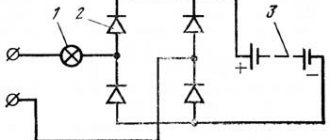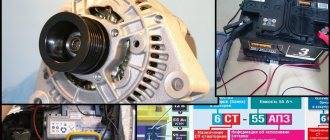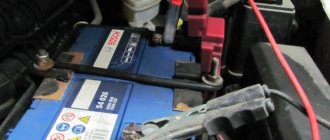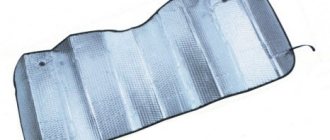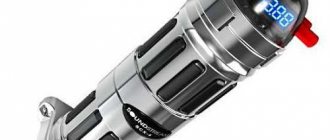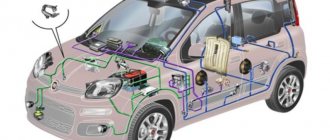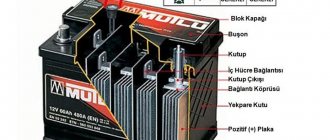Preparing the battery for the cold.
During cold weather, a car battery is not used in the best conditions. It costs a lot to start an icy engine with thickened oil, constantly run the heater, heated mirrors and rear window. From this it is obvious that during short winter trips the battery will not be able to compensate for the charge.
If the car will be used in winter and not parked in a garage or parking lot, then it is necessary to prepare the battery for harsh operating conditions before the onset of cold weather.
Checking the electrolyte level.
Almost all modern batteries have a transparent case and marks on it indicating the permissible amount of electrolyte - maximum and minimum. In cases where the battery case is not transparent or the marks are difficult to see, a glass tube is used. It must be carefully lowered into the jar under its own weight, without pressing, so as not to damage the plates and separators. Close the upper end with your finger and pull it out. The electrolyte level must be at least 10mm. If the level is low, you need to add distilled water and measure again until the level is more than 10mm. Carry out similar actions with the remaining battery banks.
How to charge your battery before winter
There are no special requirements for recharging the battery in winter. The only note is not to charge the power source in the cold. Yes, some chargers allow you to work in “snowflake” mode, providing the battery with increased voltage in low temperatures. But the process time increases significantly, and the risk of boiling the electrolyte is high.
Charging modes
The charging process standards at +20...+25°C, whether for a hybrid or AGM battery, are as follows:
- The maximum amperage is 10% of the capacity (numbers with the prefix A*h (A*h).
- The maximum voltage is 14.4 V.
What I recommend planning before winter is deep plate maintenance - desulfation. The fact is that lead sulfates are deposited on the plates even in an undercharged state, reducing the peak current output of the power source. If the battery worked hard in the summer, then in the cold it will completely give up, since the oil will become thicker, the starter will require more amps, and the chemical reactions inside the already weak battery will slow down.
First, it would be a good idea to use a diagnostic scanner to estimate the remaining amount of Ah. Perhaps the battery will have to be disposed of, or perhaps everything will work out with long-term recharging from a network device in desulfation mode.
The desulfation process itself is complex. In a nutshell, it combines a set of control and training cycles “charge-discharge”. The battery is deliberately discharged to a minimum voltage (not lower than 10.8 V), after which it is charged in pulse mode with low currents (about 2-3% of the battery capacity). The event can last several days and has a lot of “buts”. For example, calcium batteries cannot be discharged below 11.8 V, a special charger is required for recovery, etc.
A few words about the charger
Since we are talking about the charger, it is fair to note that it directly affects the health of the battery. A cheap Chinese “boiler” is in no way capable of extending the life of the product. Moreover, such a device can even cause harm. It cannot be said that such a bad state of affairs is determined only by price. No, even such reputable chargers as Bosch C7 and Stack can upset the balance of the power supply if you work with them strictly according to the instructions.
A pulse charger can be considered worthy, which does not allow the electrolyte to boil and does not have any post-charging gadgets such as “keeping the battery charged”, “storing”, etc. These are, as a rule, fully programmable combines like the 912 Coulomb or a homemade alternative from Magpies (pseudonym).
It is clear that trouble-free service life also depends on the quality of the power source itself. We talked about which battery is better to choose a month ago. Then I noted the specimens that didn’t even care about the correct chargers - they still failed after 2-3 years.
Operating the battery in winter
Winter is a test not only for people and all living organisms, but also for cars in general and their components in particular. We will talk about how to properly store, operate and care for a car battery.
During the winter season, the battery discharges its capacity much faster than in the warm season. Agree that stalling in the middle of a winter road is an unpleasant event. After all, even waiting for the tow truck to arrive will have to be in the cold - you won’t be able to warm up the car. Therefore, it is necessary not only to operate the battery correctly, but also to follow certain rules for storing it during the cold season.
The battery, when used correctly, will never let the driver down even in the most severe frosts. A battery that is not fully charged may not fail in the summer months, but will immediately perform poorly in the winter. Therefore, it is necessary to make it a rule to check and, if necessary, even replace the battery when entering the autumn-winter period of car operation. In the family of modern rechargeable batteries, it is very difficult to find serviceable ones, which is why, if the output current is below the standard, replacing the battery before winter is mandatory and undeniable.
These days, choosing a battery is not particularly difficult. It all depends on the financial capabilities of the car owner and his preferences for one or another brand of battery manufacturer. Some domestic car owners make such a common mistake as purchasing and installing a new battery with obviously greater power than is provided for in the technical characteristics of the car. In this case, both the car’s generator suffers, because it bears an increased load, and the battery itself - the installed generator is not able to fully charge the battery, as a result of which its service life is significantly reduced. Before installing a new battery on a car, you need to check the polarity of the terminals to avoid trouble.
Preparing your car for winter: the main myths about the battery
Winter will soon come to Ukraine and drivers should prepare their cars in advance for the weather conditions of this period of the year. Particular care must be taken when servicing the battery, without which the car will not be able to drive.
Myths about the main source of electricity in a car are still popular among drivers. If you follow basic rules, the battery will last a long time and will not fail.
Myth No. 1: A heavy battery is a reliable battery.
You should not focus on the weight of the battery when choosing. It’s like with motor oil – the base is the same, but the additive package is different. This affects the difference in price and basic properties. With a fairly simple battery design, the same for most brands, various additive components are added to the active mass of the plates. Typically, manufacturers do not disclose their composition. The maximum starting current depends on these additives more than on the mass of lead.
Myth #2: Exceeding the "amp hours" will burn out the electrical system.
Popular articles now
Weather for tomorrow: Ukrainians were warned about contrasts - some will feel summer warmth, while others will be flooded with autumn-like rains
A 13-year-old schoolgirl disappeared in the Frankivsk region, her parents are in tears begging for help - “Where are you, Dianka?”
Mom buried her son who died in Donbass, and he “resurrected” a year later: “Escaped from hell”
Tina Karol pulled off her panties and named the date that all Ukrainians are waiting for
show more
When choosing a battery, an ordinary buyer should focus specifically on the maximum current that the battery can deliver. The parameter is indicated on the battery case as CCA - cold cranking amps. The higher the parameter, the better. A battery with a popular capacity of 60 Ah with the same dimensions can have a CCA in the range from 480 to 620 amperes - a difference of 1.3 times and that’s a lot.
The ampere-hour capacity should be no less than that recommended in the owner's manual. On the larger side, there are no restrictions other than size and common sense. Common myths that a high-capacity battery will “burn out the starter or generator” are nonsense.
Myth No. 3: The health of the battery can be checked with a load fork.
The store salesperson traditionally pokes a load fork into the terminals of the selected battery to simulate a starter. This shows the health of the battery. But this procedure still does not give any conclusions. The main parameter of the battery is the maximum starting current CCA. It is tested at a temperature of -18 degrees. But the load plug loads the battery with much less current and at room temperature.
Myth No. 4: “lighting up” in winter is completely safe for the battery
In order for the battery to remain serviceable after a winter discharge at low temperatures, it must be removed from the vehicle and kept warm. You only need to replenish the charge with a special device. The electrolyte freezes as the density drops. Ice crystals begin to form from the bottom, the current flows only through the upper part of the plates, causing deformation, shedding, and burns from short circuits.
After starting, a frozen battery immediately begins to charge, and this only kills it. The battery loses its properties faster and this process is irreversible. If the battery case is swollen after freezing, then you can safely buy a new one. The battery's ice crystals destroyed the plates and the active mass was squeezed out of them.
How to maintain your battery
Let us remind you that the Znayu portal previously reported that in winter, car owners are forced to leave the house earlier to start the vehicle and painfully wait several minutes for it to warm up. However, there is a way you can make your life easier.
Car battery
Increased load in winter falls on the battery. Be sure to check the electrolyte level, charge level and condition of the terminals.
It is not recommended to leave the car without moving for a long time, since in winter the battery charge is consumed quite quickly.
The terminals must be checked and cleaned of deposits to ensure good power conductivity. Remember that the battery is the heart of the car and one of the most important components, and if we are preparing the car for winter, be sure to check its condition immediately after changing the tires.
Preparing the battery for winter
Charging your battery while preparing for winter
The first and most important step in preparing a battery for the winter is charging it. First of all, you need to remove the battery from the vehicle, and then thoroughly clean it to remove all types of contaminants. The next step is to clean the terminals with sandpaper, which improves contact (current conductivity).
Before charging a car battery, it is necessary to unscrew the plugs from the filler holes (cans), which will give access to the electrolyte and check its level. Optimally, it should cover the plates by 1-1.5 centimeters. If this condition is not met, you need to take distilled water and add it to all holes.
The next step is charging the battery. To simplify this process as much as possible, it is advisable to purchase a popular charger (charger), which allows you to minimize the amount of work performed. During this you need to follow some rules:
- It is necessary that the plugs remain unscrewed (open filler necks).
- When connecting the charger to the battery, it is important to observe the polarity: the black wire is the negative terminal, the red wire is the positive terminal. An error in polarity can damage the charger, with the exception of devices that have special protection.
- Once you have connected the charger to the battery, you can plug it into the power supply.
- Expensive chargers prevent the electrolyte from boiling strongly during charging; however, it is recommended to carry out the battery charging procedure in a ventilated, and preferably non-residential, area (for example, a loggia or garage, or, in extreme cases, a corridor).
- Leave the battery to charge; this procedure takes from 10 to 13 hours.
- You can verify that charging is complete by checking the gas bubbles released from the electrolyte.
Once the battery is fully charged, it must be unplugged and left for a couple of hours to settle.
What to carry with you in your car in winter
When preparing your car for winter, you need to take care not only of its driving properties, but also of various items that are in the trunk or interior. In winter, it is recommended to carry the following accessories with you:
Scraper. A necessary item for cleaning glass and bodywork from snow and ice in winter;- Metal shovel. She runs the risk of being required to dig the car out of the snow;
- Battery cables for lighting. If problems arise with starting the engine, the driver can try to “light” another car. It is better to store your own wires in the car;
- Cable. A tow rope won't hurt in winter, especially if the car is driven outside the city where the roads are not cleared.
Preparing your car for winter is an important and lengthy procedure. If the car will be used throughout the winter, it is necessary to carry out all the work described in this article, then the risk of being “stuck” on the road due to cold weather will be brought closer to zero.
( 376 votes, average: 4.49 out of 5)
How to check alloy wheels when purchasing
Tips for novice car enthusiasts: how not to ruin your new car
